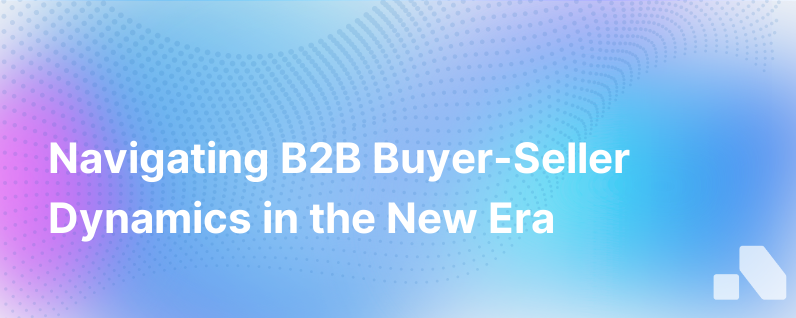
The seismic shifts within B2B buyer and seller dynamics have been profound, reshaping the landscape of sales and purchasing as we know it. With the rise of digital channels, empowered buyers, and the global tumult that has defined the last few years, businesses have been challenged to meet their customers' needs in ways that are increasingly sophisticated and nuanced.
In this in-depth exploration of the B2B buyer-seller dynamics, we'll unravel how these changes have manifested and what your organization can do to stay ahead. It's a profound paradigm shift, marked by technological innovation, evolving expectations, and novel sales methodologies that draw from a deep understanding of both data and psychology.
Understanding the New B2B Buyer
One of the most significant changes is in the profile of the B2B buyer. Today’s buyers are digital natives; they commence their buying journey online and expect to find extensive information, reviews, and testimonials at a click. The freedom of self-service and the ability to explore options without sales pressure are paramount to them.
They are typically well-informed with a trove of resources at their disposal, from whitepapers and case studies to forums and peer reviews. The competitive landscape means that they are not just looking for a vendor but a strategic partner who can contribute real value to their business.
Evolving Sales Strategies
This new buyer journey means that traditional sales tactics have declined in effectiveness. Cold-calling, hard-sell tactics, and formulaic sales pitches have given way to inbound marketing, content marketing, personalized outreach, and consultative selling.
Sales teams need to be more agile than ever, leveraging data analytics to understand customer behavior, predict needs, and tailor the customer experience. Sales enablement tools powered by artificial intelligence can provide actionable insights that help reps deliver the right message, to the right person, at the right time.
The Role of Sales Enablement Platforms
The complexity of modern B2B sales has increased the importance of sales enablement platforms. These platforms offer a range of tools to support the sales process, from CRM and content management to analytics and training. With integrated AI, these platforms can identify patterns, predict outcomes, and provide personalized recommendations.
A platform like Aomni streamlines account research, assimilates competitive intelligence, and delivers personalized sales content in real-time, enhancing the buyer's journey and bolstering the seller's capability to respond aptly and punctually to client needs.
The Integrated Marketing Approach
Any discussion about changing sales dynamics is incomplete without the mention of marketing's evolving role. Marketing teams now work hand-in-hand with sales, providing valuable insights, nurturing leads through targeted content, and contributing to account-based marketing strategies. The line between sales and marketing blurs as they converge towards a unified goal of customer acquisition and expansion.
Marketing initiatives augmented by tools like marketing automation, predictive analytics, and account-based marketing software are becoming more targeted, nurtured, and aligned with the personalized needs of each prospect or customer.
The Relationship-Building Phenomenon
In the face of the digital revolution, one might assume that human connections have diminished in importance. On the contrary, relationship-building has become more critical than ever. Personalizing communications, understanding the unique challenges of each business, and fostering trust are central to sales success in the B2B realm.
Sales professionals must now be adept at consultative selling—advising rather than pitching—demonstrating empathy, taking on a role akin to that of a trusted advisor. In-depth knowledge of the customer’s industry, business, and specific challenges is critical.
The Data-Driven Landscape
Data is the currency of the new B2B marketplace. Harnessing and interpreting data not only informs sales and marketing strategy but also leads to predictive capabilities that can guide decision-making. A robust data analytics operation is now a cornerstone for any B2B organization aspiring to lead.
Navigating a New Competitive Landscape
Every change in buyer behavior brings about new competition. Sales organizations must not only sell against traditional competitors but also against the promise of self-service models, alternative solutions, and distractions in an ever-noisy marketplace. Staying top of mind now requires an omnichannel approach that consistently engages the buyer across various platforms.
Talent and Training
Finally, the demand for new skills among sales professionals has never been higher. The ability to navigate sophisticated software platforms, interpret data, understand digital marketing principles, and cultivate deep relationships is mandatory. As a result, organizations are investing more in continuous training and development to keep their teams competitive.
Conclusion
The seismic shift in B2B buyer-seller dynamics cannot be overstated. It presents both challenges and opportunities, pushing sales organizations towards technological adoption, strategic planning, and a deeper investment in understanding the customer journey.
Organizations that respond proactively—adapting their approach, investing in enablement tools, and committing to ongoing education—will not only navigate this shift but thrive within it. It's not without its toils, but with a dedicated focus on the evolving nature of B2B sales, companies can build more robust, mutually beneficial, and enduring customer relationships.
In this emerging landscape, solutions like Aomni that provide real-time intelligence and personalized sales strategies are not just advantageous—they're essential. They embody the change that has overtaken the industry, enabling sales teams to meet and exceed the expectations of the modern buyer.